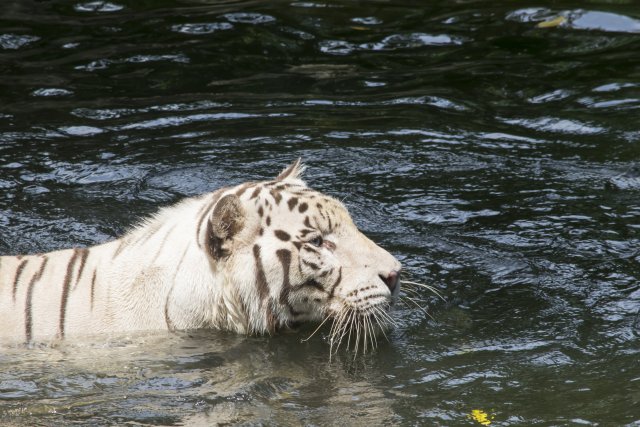Roaring Waters: Tigers’ and their Incredible Swimming Skills
Roaring Waters:
A Closer Look at Tigers’ Swimming Technique
Tigers are known for their strength, agility, and majestic presence. These magnificent creatures are not only skilled hunters on land but also possess impressive swimming abilities. In this article, we will delve into the fascinating world of tigers’ swimming technique, exploring their adaptations, hunting strategies, and the importance of water in their lives.
The Adaptations of Tigers for Swimming
Tigers have several physical adaptations that enable them to navigate through water with ease. Their muscular bodies, powerful limbs, and webbed paws make them well-suited for swimming. The webbing between their toes acts as a paddle, providing increased surface area for propulsion and better maneuverability in the Roaring Waters.
Furthermore, tigers have a layer of fat beneath their skin, which not only helps with buoyancy but also provides insulation in colder waters. This adaptation allows them to swim comfortably in various environments, from tropical rivers to icy lakes.
Roaring Waters: The Role of Water in a Tiger’s Life
Water plays a crucial role in a tiger’s life, serving various purposes beyond mere survival. Tigers are known to be excellent swimmers, and they often use water as a means to cool down, escape the heat, and even hunt their prey.
One of the primary reasons tigers take to the water is to regulate their body temperature. In hot climates, tigers often seek relief from the scorching sun by submerging themselves in water bodies. This behavior helps them cool down and prevents overheating, allowing them to conserve energy for hunting and other activities.
Additionally, tigers are skilled ambush predators, and water provides them with a strategic advantage. They can silently approach their prey by swimming stealthily, minimizing the chances of detection. This technique is particularly effective when hunting animals that rely on their sense of hearing to detect predators.
Roaring Waters: Tigers’ Hunting Strategies in Water
When it comes to hunting in water, tigers employ different strategies depending on the circumstances and the type of prey they are targeting. One of their most remarkable techniques is known as the “belly crawl.”
The belly crawl involves a tiger submerging itself in water, with only its eyes, ears, and nostrils above the surface. By keeping a low profile, the tiger can approach its prey undetected, relying on its exceptional camouflage and patience to get close enough for a successful ambush.
Another hunting strategy employed by tigers in water is the “stalk and pounce” technique. This method involves the tiger stealthily swimming towards its prey, carefully calculating the distance and timing of its attack. Once within striking range, the tiger launches itself out of the water, using its powerful limbs to overpower the unsuspecting prey.
Case Study: Tigers in the Sundarbans
Roaring Waters: The Sundarbans, a vast mangrove forest shared by India and Bangladesh, is home to the largest population of Bengal tigers in the world. These tigers have adapted to their unique environment, which is characterized by a complex network of rivers, swamps, and tidal creeks.
Living in such a water-rich habitat has shaped the behavior and swimming abilities of the tigers in the Sundarbans. They are known to swim long distances between islands, using their powerful strokes to navigate the strong currents and tidal movements.
Furthermore, the Sundarbans tigers have developed a unique hunting technique. They often lie in wait near the water’s edge, patiently observing their prey. When the opportune moment arises, they swiftly enter the water, swimming silently towards their target before launching a surprise attack.
The Importance of Conservation Efforts
Roaring Waters: Despite their remarkable swimming abilities, tigers face numerous threats to their survival. Habitat loss, poaching, and human-wildlife conflict have significantly impacted tiger populations worldwide. Roaring Waters: Conservation efforts are crucial to protect these magnificent creatures and ensure their continued existence.
Preserving the natural habitats of tigers, including the water bodies they rely on, is essential. This involves protecting forests, wetlands, and rivers from deforestation, pollution, and encroachment. Additionally, efforts to combat illegal wildlife trade and raise awareness about the importance of tiger conservation are vital.
Summary
Roaring Waters: Tigers are not only fierce predators on land but also skilled swimmers. Their physical adaptations, such as muscular bodies and webbed paws, enable them to navigate through water effortlessly. Water plays a significant role in a tiger’s life, providing relief from heat and serving as a strategic hunting ground. Tigers employ various techniques, such as the belly crawl and stalk and pounce, to hunt their prey in water.
Case studies, such as the tigers in the Sundarbans, highlight the unique adaptations and swimming abilities of these majestic creatures. However, conservation efforts are crucial to protect tigers and their habitats from the numerous threats they face. By understanding and appreciating the swimming prowess of tigers, we can contribute to their conservation and ensure their survival for generations to come.
Escape to Nature’s Haven: Turpentine Creek Wildlife Refuge in Eureka Springs, AR




